Model-Based Analysis and Improvement of Vehicle Radiation Emissions at Low Frequency
Abstract
:1. Introduction
2. Problem Description
2.1. Simultaneous Existence of Small and Large Electrical Parts
2.2. Complexity of Potential Factors, Coupling Paths and Failure Modes
2.3. Balance between Performance, Engineering Application and Costs
- (1)
- The complete vehicle radiation problem is divided into multiple submodels by:
- (a)
- The shielding effect of such metal structures as vehicle body, component shell, etc.;
- (b)
- The electrical size of the modeled components.
- (2)
- The modelling difficulty of each subsystem is comparatively reduced. Moreover, different subsystems can be modelled by different methods. How to decouple the vehicle radiation problem is discussed in Section 3.1.
- (3)
- The multi-port network characterized by Z-parameter is adopted to describe the internal couplings of subsystems caused by the near field and electromagnetic radiation. It is not necessary for the engineer to extract the equivalent vehicle radiation model exactly. The final interference is obtained by solving an algebraic equation including the functions of multi-port networks and their connection topologies. Compared with the 3D numerical method, this reduces the requirement of computational resources greatly. The topological model for vehicle-level radiated emissions is introduced in Section 3.2.
- (4)
- The influences of different technical factors on radiated emissions are evaluated quantitatively and directly base on the model by considering their sensitivities and contributions. The engineer need not provide possible improvement measures in advance. The details of the evaluation process can be found in Section 4.1.
- (5)
- The tree structure is suggested to model all factors including both technical and untechnical ones, which influence the determination of final solutions. Only the comparative importance among different factors belonging to the same category need to be evaluated by the engineer. This is easier to implement in practice and reduces the requirement of engineer’s experience. The model-based improvement process is discussed in Section 4.2.
3. Topological Modelling Process
3.1. Decoupling of Vehicle Radiation Problem
- (1)
- Most components are electrical small and wrapped in metal shells, which are well grounded. Such components can be considered as lumped parameter systems when studying the vehicle-level radiation emissions.
- (2)
- Vehicle manufactures focus on the system design, while the detailed design of components is carried out by the supplier. Considering both the demand for secrecy and the concerns of different roles, a decoupling structure is required to make each supplier responsible for their own parts.
- (3)
- Though there exist nonlinear materials and devices in components, their connection cables and surroundings are linear. These linear systems with their internal couplings can be described by such methods as the multi-port network, transfer function, etc.
- (1)
- The parts without direct radiation coupling with others can be considered as a separate subsystem. The direct radiation coupling means that interferences flow into and out of a part through space. At this condition, it is hard to separate the propagation of electromagnetic wave further. On the contrary, if there is no such direct radiation coupling, the part can be considered as a separate subsystem. For example, in Figure 2b, since the boundaries are metal materials which shield the radiation effectively, and only receive the conduction interference and there is no direct radiation coupling among them. As a result, they are considered as separated subsystems as shown in Figure 2c.
- (2)
- Conduction and radiation coupling paths that belong to the same volume should be integrated into one network. As shown in Figure 2b, the transfer paths between are conduction couplings in the volume . But in the same volume, there also exist other radiation couplings. These radiation and conduction paths should be integrated into one network, i.e., in Figure 2c, unless it is ensured that the coupling among the radiation and conduction paths is negligible. By this way, the requirement of prior knowledge about the radiation problem is reduced. Meanwhile, each subsystem can be modeled separately and the radiated emissions can be solved by solving an algebraic equation (see Section 3.2). The consumption of calculation resources is greatly reduced.
- (3)
- Electrical large and small subsystems are described by multi-port networks and circular nodes, respectively. The subsystems are denoted by circles in Figure 2c, and the lines represent their subordinate relationships. For an electrical large subsystem, the interference interactions among different devices are very complicated and it is difficult to find out that required to be modeled properly. To reduce the requirement of engineer’s experiences and the priori knowledge of the concerned problem, the multi-port network is adopted to describe electrical large systems denoted by the blue circles in Figure 2c. It includes all possible coupling paths and is easily to be solved numerically. The electrical small subsystems are modeled by circuit nodes (Yellow circles in Figure 2c) connected to the multi-port network. Particularly, the subsystems acting as the interference sources or sensitive equipments have to be modeled as circuit nodes.
3.2. Global Network Model
4. Model-Based Analysis and Improvement
- (a)
- A vehicle-level radiation problem may be caused by multiple factors simultaneously;
- (b)
- The determination of the final solution also depends on such untechnical factors as application difficulties and costs, which are hard to evaluate quantitatively.
4.1. Importance Analysis
4.2. Improvement Solution Selection
5. Application and Analysis
5.1. Modeling of Radiation Emission
- (1)
- The positive and negative wires are arranged in parallel and the loop area of the differential mode interferences is comparatively smaller than that of common ones. In the present modelling, only the common mode interferences are considered and the differential ones are neglected;
- (2)
- All mentioned power components in Figure 6a are packed in the metal shells, which are finely grounded;
- (3)
- PDU is a junction of all power cables and its internal schematic is shown by Figure 6b.
5.2. Problem Analysis and Improvement
6. Conclusions
- (a)
- By introducing the topological modeling method, the separate modeling and simulation can be achieved. Hence the faster simulation speed, the lower hardware requirement, and more accurate as well as more development efficient.
- (b)
- The influences of technical factors on the radiation problem can be evaluated quantitatively from the aspects of sensitivity and contribution by EWM.
- (c)
- The proposed hierarchical evaluation method can combine untechnical factors, i.e., application difficulty and cost, with the technical ones together to determine the final solution for the radiation problem.
- (a)
- In this study, it is assumed the equivalent impedance of the circuit node is independent of its working state. This is no long valid if the circuit has high nonlinearities. If nonlinear components are used to describe the node, the equivalent interference cannot be solved by Equation (6) directly. Some analysis method for nonlinear circuits is required and need to be further studied;
- (b)
- Moreover, the equivalent impedance of the circuit node is measured under the state of power off. When the circuit is activated, how to measure the equivalent impedance is still a problem especially for the high power switching circuit;
- (c)
- During the improvement process, it is possible to consider the effectiveness of the potential solutions quantitatively with the topological model;
- (d)
- In this study, only the common mode interference is considered and how to model the differential mode ones need to be further studied.
Author Contributions
Funding
Institutional Review Board Statement
Informed Consent Statement
Data Availability Statement
Conflicts of Interest
References
- Dang, D.; Gao, F.; Hu, Q. Motion planning for autonomous vehicles considering longitudinal and lateral dynamics coupling. Appl. Sci. 2020, 10, 3180. [Google Scholar] [CrossRef]
- Gao, F.; Dang, D.; He, Y. Robust coordinated control of nonlinear heterogeneous platoon interacted by uncertain topology. IEEE Trans. Intell. Transp. Syst. 2020. [Google Scholar] [CrossRef]
- Wu, C.; Gao, F.; Dai, H.; Wang, Z. A Topology-Based Approach to Improve Vehicle-Level Electromagnetic Radiation. Electronics 2019, 8, 364. [Google Scholar] [CrossRef] [Green Version]
- Ivan, E.; Fernando, A.; Mateo, J.; Alvaro, P.; Javier, P.; Francisco, J.A. Common mode noise propagation and effects in a four-wheel driven electric vehicle. IEEE Trans. Electromagn. Compat. 2018, 60, 132–139. [Google Scholar]
- Li, P.; Jiang, L.J. Source reconstruction method-based radiated emission characterization for PCBs. IEEE Trans. Electromagn. Compat. 2013, 55, 933–940. [Google Scholar] [CrossRef] [Green Version]
- Chun, H.T.; Han, S.H.; Lee, J. Converter switching noise reduction for enhancing EMC performance in HEV and EV. In Proceedings of the International Exhibition and Conference for Power Electronics, Intelligent Motion, Renewable Energy and Energy Management, Nuremberg, Germany, 10–12 May 2016; pp. 1–8. [Google Scholar]
- Jeschke, S.; Hirsch, H.; Trautmann, M.; Maarleveld, M. EMI measurement on electric vehicle drive inverters using a passive motor impedance network. In Proceedings of the Asia-Pacific International Symposium on Electromagnetic Compatibility, Shenzhen, China, 17–21 May 2016; pp. 292–294. [Google Scholar]
- Yahyaoui, W.; Pichon, L.; Duval, F. A 3D PEEC method for the prediction of radiated fields from automotive cables. IEEE Trans. Magn. Mag. 2010, 46, 3053–3056. [Google Scholar] [CrossRef]
- Gao, S.; Zhao, H.; Deng, H.; Wang, B.; Zhao, W. Estimating interference to airborne patch antennas with limited information. IEEE Trans. Electromagn. Compat. 2016, 58, 631–634. [Google Scholar] [CrossRef]
- Gao, F.; Dai, H.; Qi, J. Vehicle-level electromagnetic compatibility prediction based on multi-port network theory. Int. J. Autom. Technol. 2019, 20, 1277–1285. [Google Scholar] [CrossRef]
- Gao, F.; Dai, H.; Wu, C. A topological approach to model and improve vehicle-level electromagnetic radiation. Int. J. RF Microw. Comput. Aided Eng. 2019, 29, e21904. [Google Scholar] [CrossRef]
- Tesche, F.; Morgan, M.; Fishbine, B.; Parkinson, E. Internal Interaction Analysis: Topological Concepts and Needed Model Improvements. Interaction Notes, Summa Foundation, No. IN248. July 1975. Available online: http://ece-research.unm.edu/summa/notes/Interaction.html (accessed on 2 January 2021).
- Baum, C.E. Electromagnetic Topology: A Formal Approach to the Analysis and Design of Complex Electronic Systems. Interaction Notes, Summa Foundation, No. IN400. September 1980. Available online: http://ece-research.unm.edu/summa/notes/Interaction.html (accessed on 2 January 2021).
- Parmantier, J.P. Applications of EM topology on complex wiring systems. In International Symposium on Electromagnetic Compatibility, Germany; IEEE Press: Piscataway, NJ, USA, 1999; pp. 5–7. [Google Scholar]
- Kamruzzaman, M.; Barzegaran, M.R.; Mohammed, O.A. EMI reduction of PMSM drive through matrix converter controlled with wide-bandgap switches. IEEE Trans. Magn. 2017, 53, 8201804. [Google Scholar] [CrossRef]
- Bernas, N.R. Electromagnetic compatibility design modification considerations in electronic equipments. In Proceedings of the IEEE Symposium on Product Compliance Engineering, San Diego, CA, USA, 10–12 October 2011; pp. 1–5. [Google Scholar]
- Delgado, A.; Romero, I. Environmental conflict analysis using an integrated grey clustering and entropy-weight method. Environ. Model. Softw. 2016, 77, 108–121. [Google Scholar] [CrossRef]
- Cui, Y.; Fang, Y. Research on PCA data dimension reduction algorithm based on entropy weight method. In Proceedings of the International Conference on Machine Learning, Big Data and Business Intelligence, Qingdao, China, 23–25 October 2020; pp. 392–396. [Google Scholar]
- Duan, J.; Gao, F.; He, Y. Test scenario generation and optimization technology for intelligent driving systems. IEEE Intell. Transp. Syst. Mag. 2020. [Google Scholar] [CrossRef]
- Gao, F.; Duan, J.; Han, Z.; He, Y. Automatic virtual test technology for intelligent driving systems considering both coverage and efficiency. IEEE Trans. Veh. Technol. 2020, 69, 14365–14376. [Google Scholar] [CrossRef]
- Ge, Q.X.; Wang, Y.J.; Liu, L. Analytical hierarchy process judgement matrix remodeling basing on artificial neural network. In Proceedings of the IEEE Control & Decision Conference, Qingdao, China, 23–25 May 2015; pp. 2945–2950. [Google Scholar]
- Zhang, G.; Wang, L.; Duffy, A.P.; Di Febo, D.; Orlandi, A.; Sasse, H. Applying the analytic hierarchy process (AHP) to an FSV-based comparison of multiple datasets. IEEE Trans. Electromagn. Compat. 2015, 57, 477–483. [Google Scholar] [CrossRef]
- Performance Levels and Methods of Measurement of Magnetic and Electric Field Strength from Electric Vehicles, Broadband, 150 kHz to 30 MHz. SAE J551-5. 2012. Available online: https://www.sae.org/standards/content/j551/5_200401/ (accessed on 2 January 2021).
- Schoeman, M.; Attardo, E.A.; Castany, J.S. Recent advances to the FEKO integrated cable harness modeling tool. In Proceedings of the International Symposium on Electromagnetic Compatibility, Barcelona, Spain, 2–6 September 2019; pp. 1071–1075. [Google Scholar]
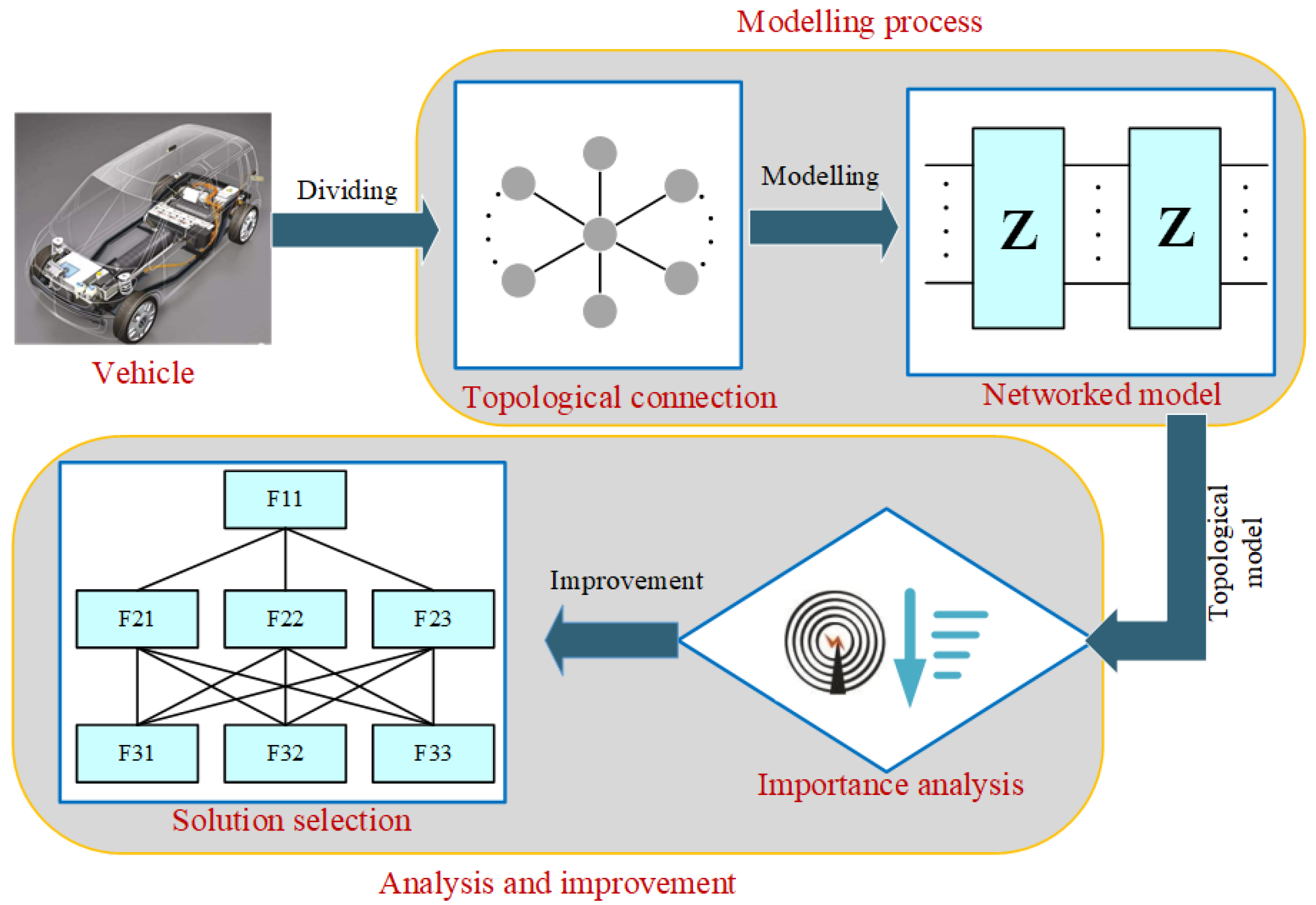

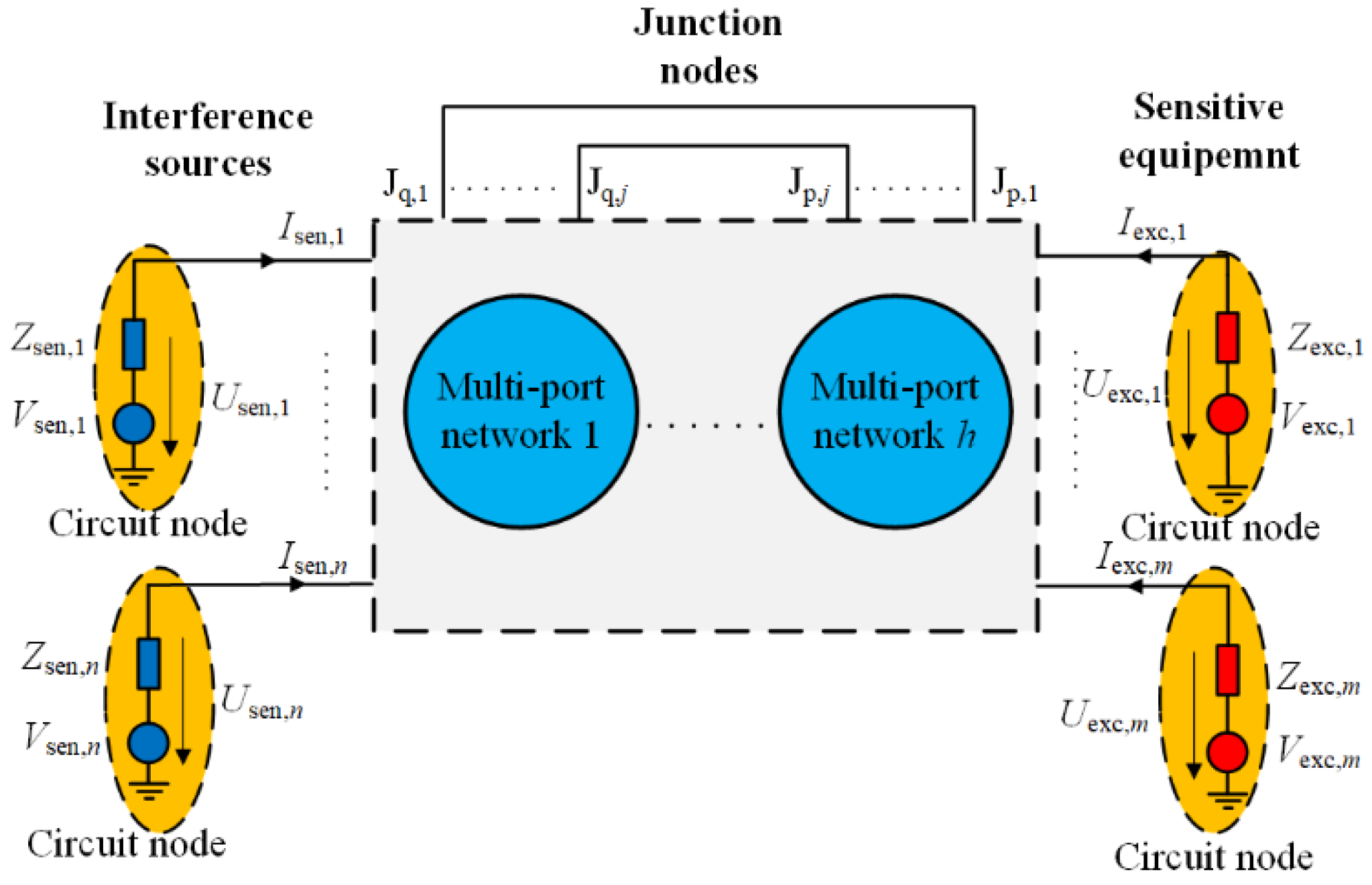
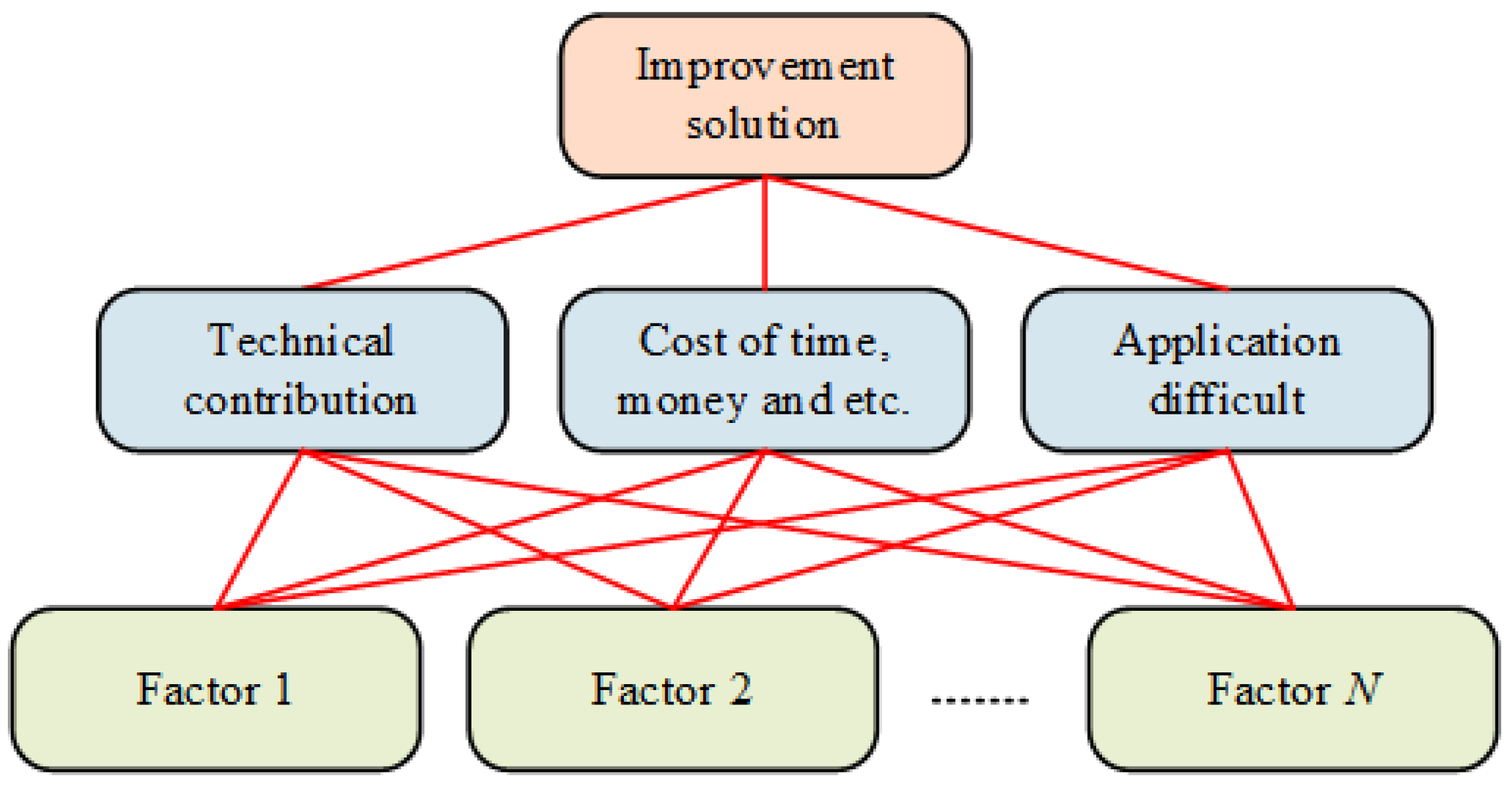
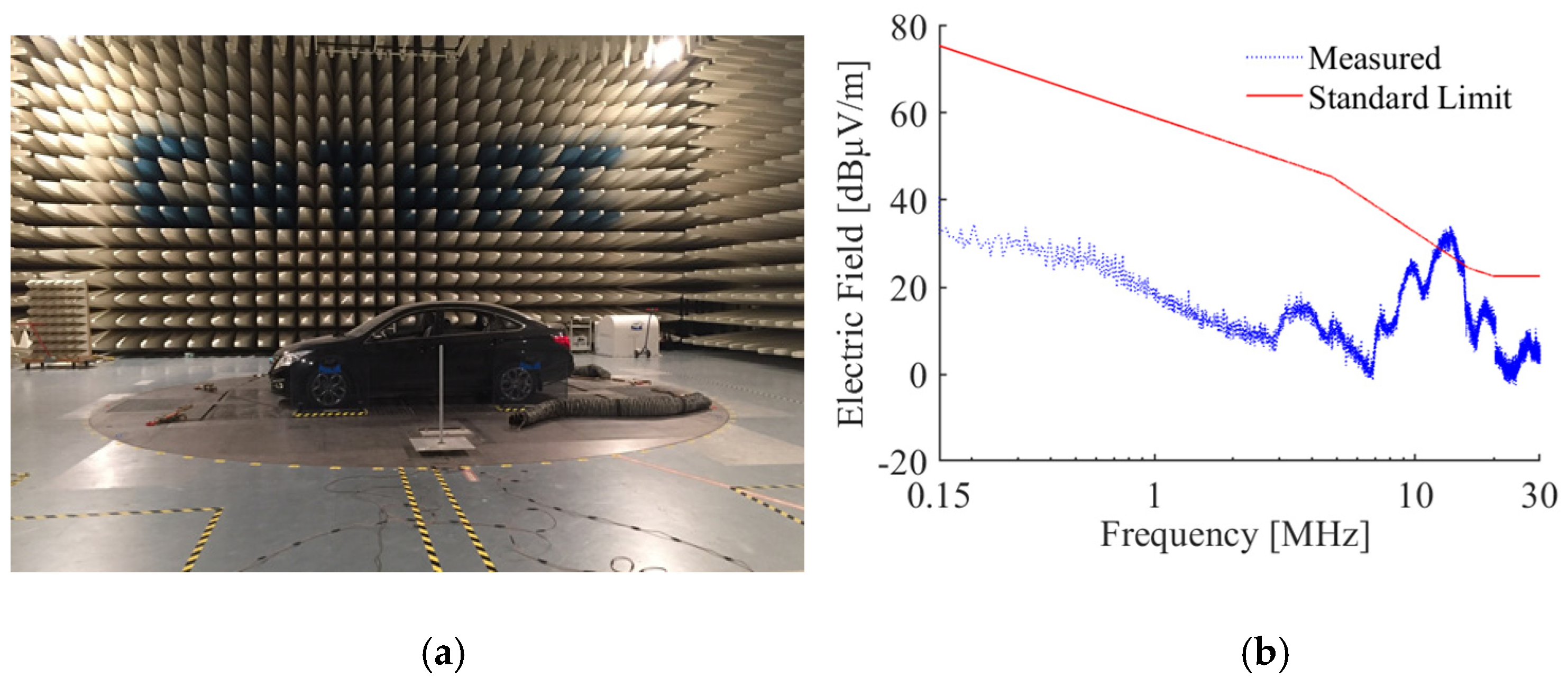


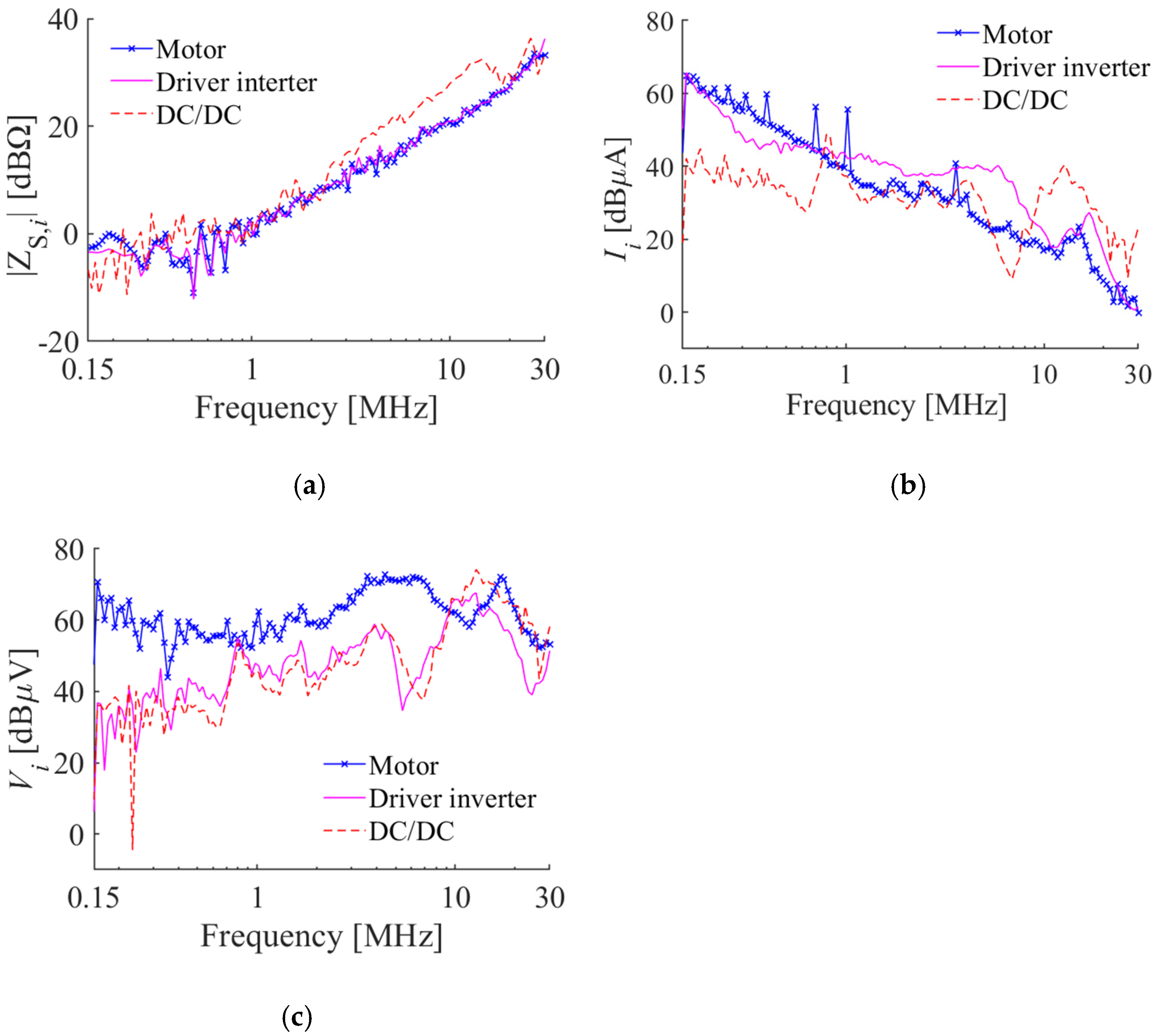
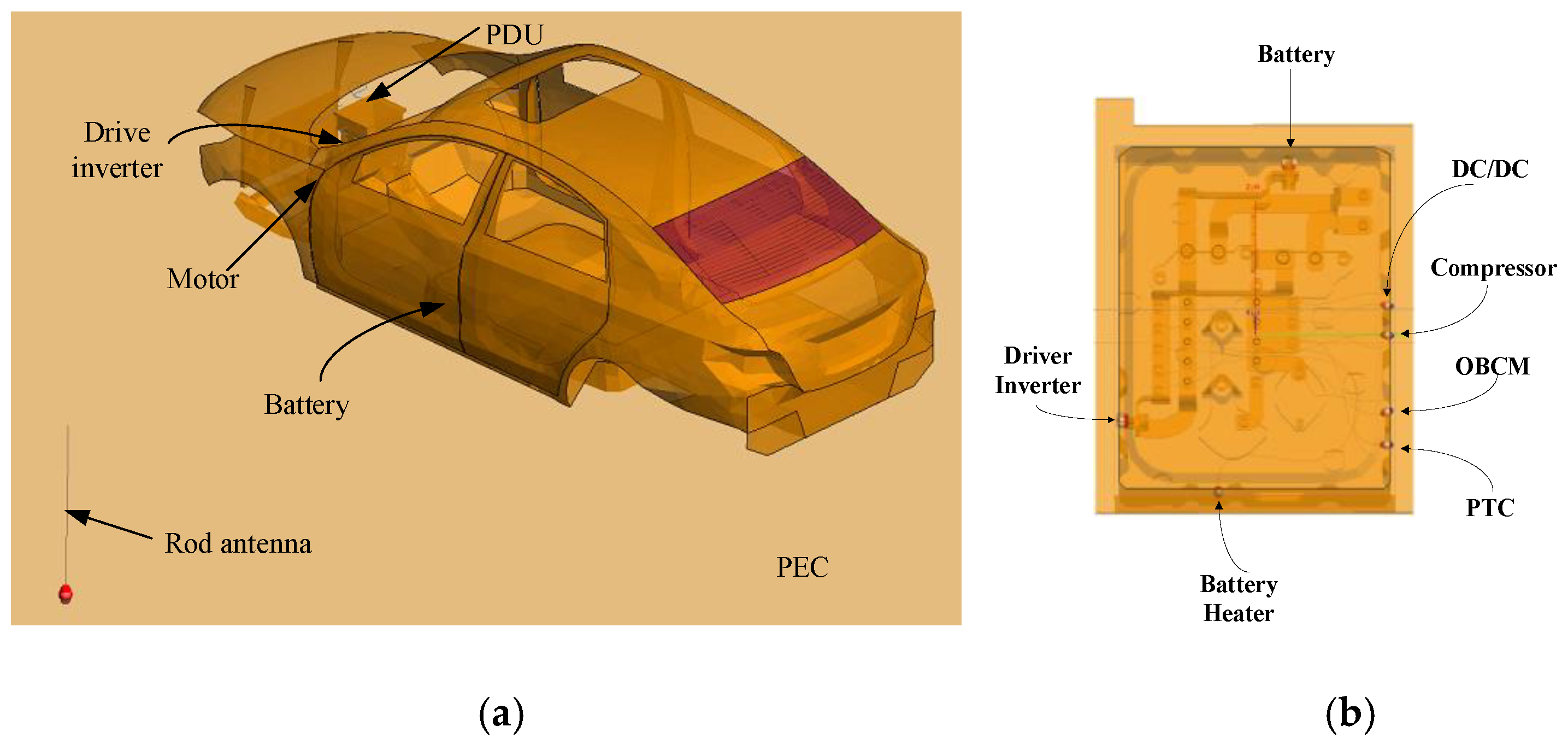

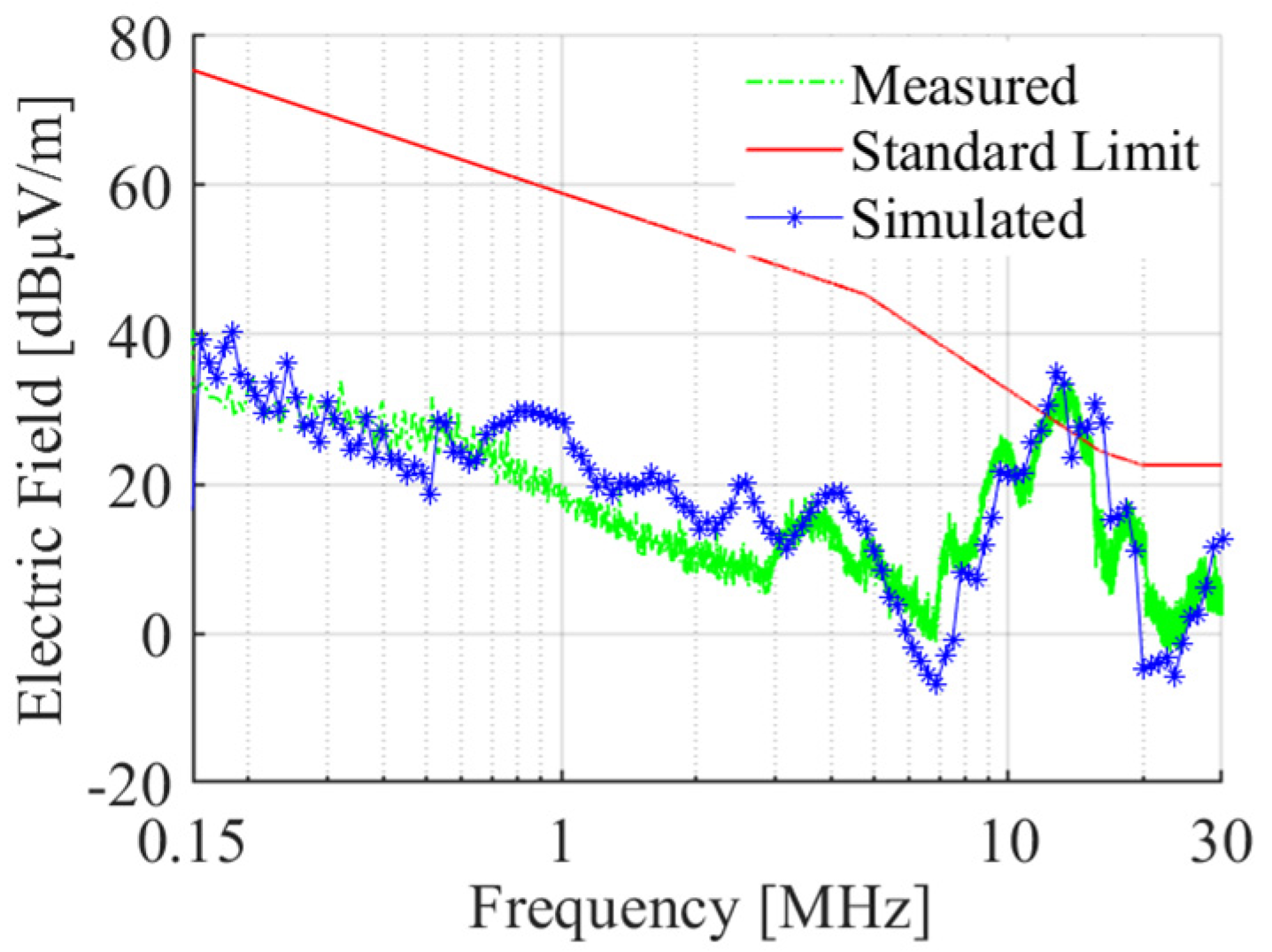

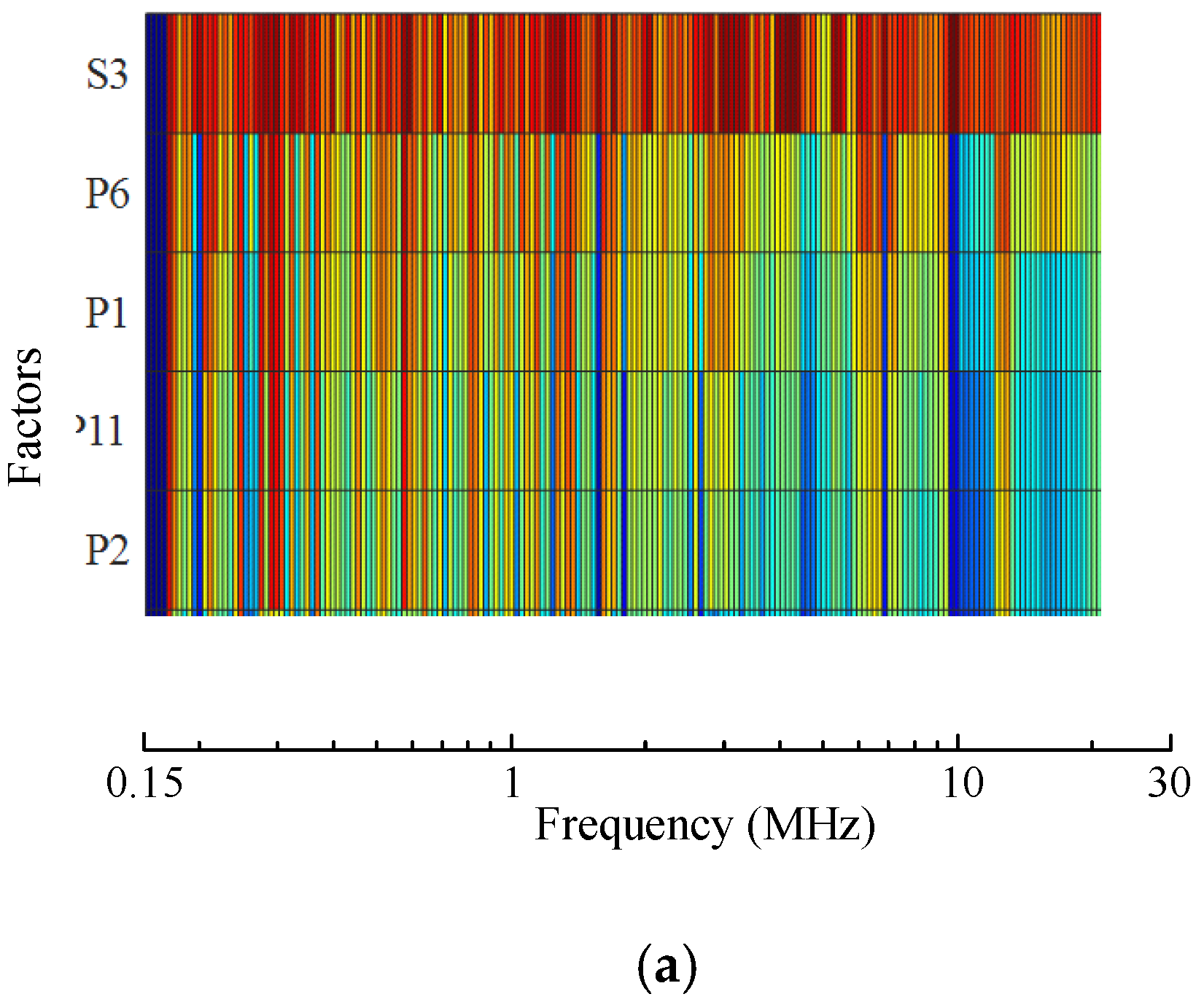
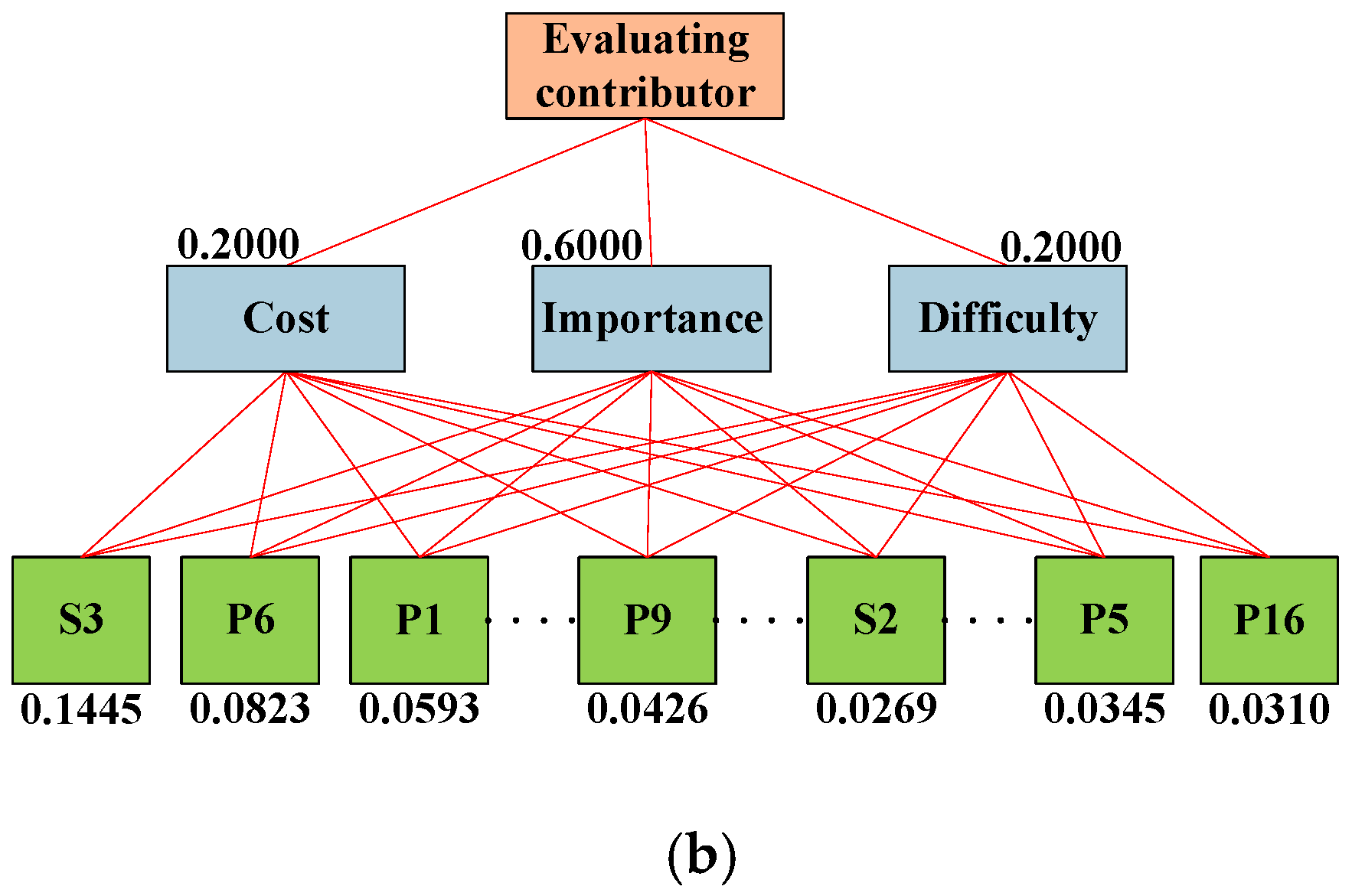
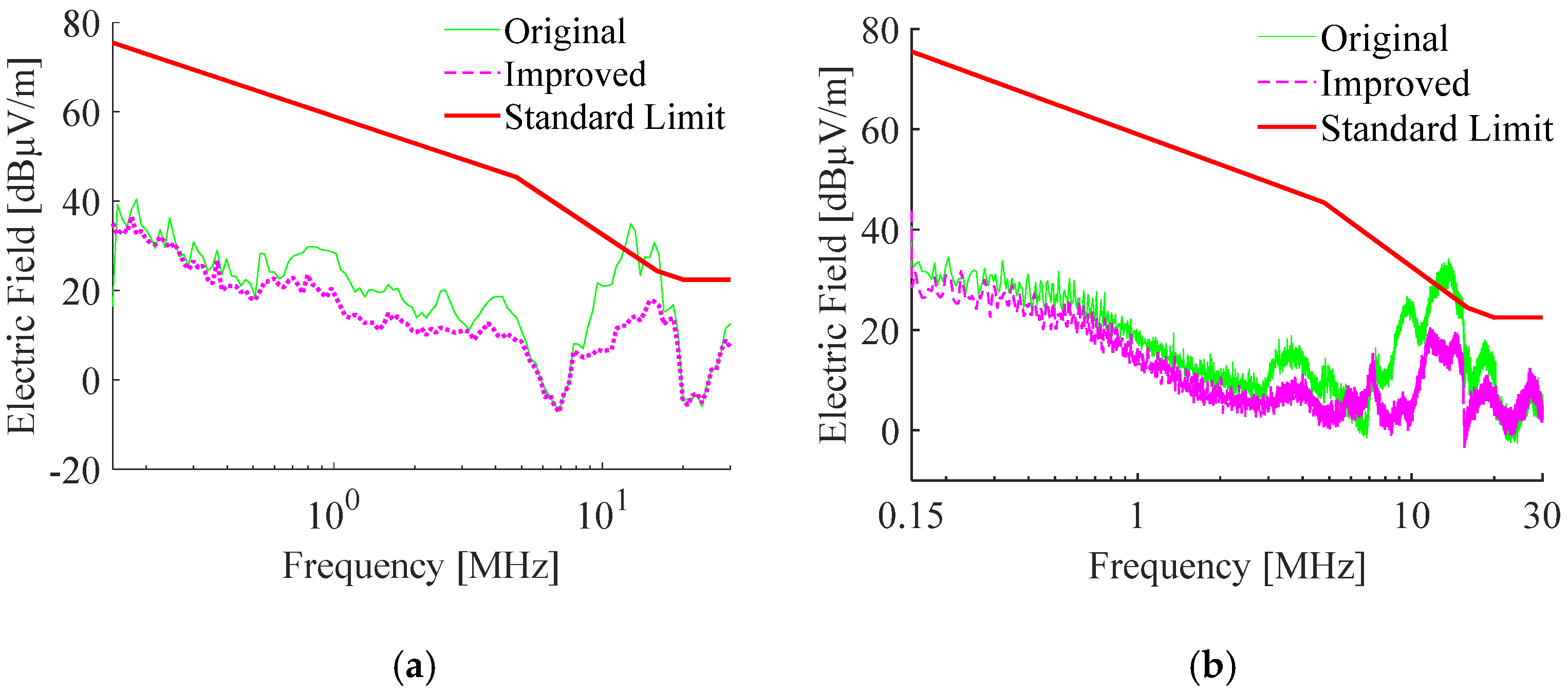
| Advantages | Disadvantages |
|---|---|
|
|
Publisher’s Note: MDPI stays neutral with regard to jurisdictional claims in published maps and institutional affiliations. |
© 2021 by the authors. Licensee MDPI, Basel, Switzerland. This article is an open access article distributed under the terms and conditions of the Creative Commons Attribution (CC BY) license (https://creativecommons.org/licenses/by/4.0/).
Share and Cite
Gao, F.; Wang, Q.; Xiong, Y. Model-Based Analysis and Improvement of Vehicle Radiation Emissions at Low Frequency. Appl. Sci. 2021, 11, 8250. https://doi.org/10.3390/app11178250
Gao F, Wang Q, Xiong Y. Model-Based Analysis and Improvement of Vehicle Radiation Emissions at Low Frequency. Applied Sciences. 2021; 11(17):8250. https://doi.org/10.3390/app11178250
Chicago/Turabian StyleGao, Feng, Qing Wang, and Yu Xiong. 2021. "Model-Based Analysis and Improvement of Vehicle Radiation Emissions at Low Frequency" Applied Sciences 11, no. 17: 8250. https://doi.org/10.3390/app11178250
APA StyleGao, F., Wang, Q., & Xiong, Y. (2021). Model-Based Analysis and Improvement of Vehicle Radiation Emissions at Low Frequency. Applied Sciences, 11(17), 8250. https://doi.org/10.3390/app11178250







